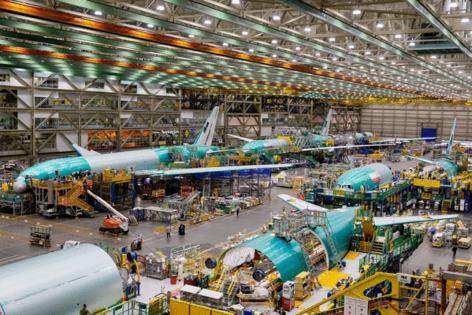As strike looms, Boeing pushes 777 jets through chaotic production
Published in Business News
For months, Boeing’s leadership has claimed repeatedly that slowing the pace of jet production and renewing the focus on inspections will ensure production quality. As a potential strike by 33,000 machinists looms next week, that’s not the reality mechanics see inside Boeing’s widebody jet plant in Everett, Washington.
Managers there are currently pushing partially assembled 777 jets through the assembly line, leaving tens of thousands of unfinished jobs due to defects and parts shortages to be completed out of sequence on each airplane, according to three people working directly on 777 assembly.
Though the production rate of 777 jets is at a crawl, with a total of just 11 deliveries so far this year, employees describe a chaotic workplace.
Mechanics are chasing airplanes through the Everett factory to install systems that should have gone in earlier and to complete rework of defects on 777 cargo planes that have traveled far down the assembly line and even outside onto the Paine Field flight line, said a veteran 777 mechanic who works on fuselages.
At the 737 Max plant in Renton, Washington, Boeing has said it is severely limiting such “traveled work,” which requires installing parts out of the normal assembly sequence. The practice contributed to the Alaska Airlines door plug blowout in January.
“It’s not the way the hourly workers want to do business,” said the veteran mechanic, alarmed by the state of 777 production. “We’re shooting ourselves in the foot.”
A longtime 777 quality inspector in Everett — who, like the other employees quoted here, requested anonymity because he feared retaliation — said Boeing has moved new inspectors onto the assembly line who are unfamiliar with the work.
“They are not being trained, just thrown to the wolves,” he said.
Boeing personnel conducting inspections out on the airfield flight line are finding multiple structure, systems and interior defects that were missed inside the factory.
“Things have gotten worse, not better. It’s embarrassing,” the quality inspector said. Managers are “shoving the airplanes through the factory causing this mess.”
Several employees said management is pushing to complete three almost-finished 777 freighters before the machinists go on strike, which could begin next week at midnight on Thursday.
Meanwhile, at the start of the 777 assembly process, relatively inexperienced new hires are working in a separate building putting together the 777 fuselages and running two or three days behind schedule on each aircraft.
Mechanics there are trying to complete the fuselage for a new 777-9X passenger jet before that machinists strike deadline.
Boeing spokesperson Jessica Kowal in an emailed statement said the company has “deliberately slowed 777/777X production as part of broader efforts to stabilize our factories and work through supply chain challenges.”
“We will continue to take the time necessary to work through factory disruption,” she continued. “Our teams on the factory floor know how best to build our airplanes, and we’ll continue to listen and incorporate their feedback.”
As part of a series of whirlwind introductory tours, Boeing’s new CEO Kelly Ortberg visited the Everett factory on Aug. 16 and was shown around by Jason Clark, vice president of the 777/777X program and Everett site leader.
While Ortberg was there, front-line workers held one of their raucous daily protest marches through the assembly building to loudly proclaim their contract demands and demonstrate their militancy.
The veteran 777 mechanic said he has high hopes Ortberg will eventually drive positive change at Boeing, but said the CEO didn’t get to talk to many front-line employees on that visit.
“I don’t think he got the picture of how bad things are,” he said.
Difficulty building the 777 fuselage
Boeing begins assembly of the 777 in Everett inside a purpose-built facility located behind the main jet assembly building. There, workers rivet together the large fuselage panels that arrive from Japan.
This work of stitching together the fuselage has been problematic since 2016 when Boeing introduced a new way of holding the panels in place.
Engineers had designed that new assembly system to use riveting robots that ultimately proved incapable of the necessary precision.
Boeing finally gave up and abandoned the robots in 2019. Ever since, mechanics have built the fuselages by hand.
Without the fixtures that held the panels in place in the old way of building the 777, however, the panels are very difficult for mechanics to align properly.
So for every fuselage built, engineers use lasers to measure the misalignments between skin panels and the force needed to make them flush with one another, feeding the data to stress engineers.
This painstaking process has added two to three days to what is supposed to be a five-day build, the veteran mechanic said.
He said the fuselages for about nine 777s completed recently moved out to the final assembly bay with 8,000 jobs behind schedule. That’s not including repairs to skin and fastener defects.
Cannibalizing 777-9Xs for parts
Outside on the flight line, mechanics are currently installing some basic wiring and electrical components in 777 freighters, said a systems installer who has worked on 777s for more than 5 years.
The electrical wiring is the nervous system, or the guts, of the airplane, typically the first system installed when the fuselage enters the main assembly building, before the wings are attached. It’s vastly out of sequence to be doing this on the flight line.
“That’s what we’re doing: Getting the guts in there,” the system installer said of the flight line work.
Due to parts shortages of things like power panels and electrical components, he said only “the bare minimum” of systems were installed on five 777 cargo planes before they moved out of the factory.
Only after the wiring was completed could freighter interior features — such as sidewall liners and light fixtures — be installed, again out on the airfield.
Boeing said in a statement that “we continue to face supply constraints across our factories, which drives rework and traveled work. Traveled work is a reality for any manufacturing system.”
Kowal, the Boeing spokesperson, pointed to a statement by Boeing Senior Vice President Mike Fleming in May that zero traveled work “is not always possible in a manufacturing environment,” and that Boeing is “putting criteria and safety controls in place to manage traveled work.”
Another aspect of the out-of-sequence work, according to the systems installer, is that due to supply chain shortages some parts had to be taken from other planes inside the factory and put on 777s close to delivery.
“They were stealing parts from some planes and putting them on others,” he said.
In addition to the three employees quoted, an additional mechanic and another who recently left Boeing — both of whom also worked on 777/777Xs and also requested anonymity to protect their jobs — said mechanics sometimes have even cannibalized the completed 777-9Xs in long-term storage on Paine Field.
With the 777-9X still not certified to carry passengers, about 30 have been built that cannot be delivered until 2026.
A mechanic whose job is to take care of those 777-9Xs to make sure the systems don’t deteriorate in storage said parts have been removed several times without any notice to his team or documentation of the removal — a serious breach of Federal Aviation Administration regulations.
In light of this allegation, Boeing said it is “reviewing our documents and airplanes in storage to ensure accuracy in our record keeping.”
“Every employee who becomes aware of an undocumented removal has an obligation to report it. We ask that anyone with knowledge of this should provide detailed information through our ‘Speak Up’ system.”
At the other end of the process, where assembly begins, mechanics in the fuselage build area are this week pushing to complete the fuselage of a new 777-9X.
The fuselage panels for that jet — line number 1781, which could be one of the first 777-9Xs delivered to an airline — were loaded into the cradles for assembly only on Tuesday and it will take at least seven or eight days to complete the fuselage work if there are no major holdups.
An FAA audit scheduled for Friday in the fuselage facility could get in the way.
If done in time, that fuselage will likely sit out any strike there and move to the final assembly bay only when it’s over.
The machinists union is demanding a wage increase of 40% over three years. According to the union, Boeing’s counteroffer this week was far off that.
The divide will be difficult to close. Of many machinists consulted about the contract talks over the past few days, all fully expect a strike to commence next week, with some suggesting it could last months.
Two 777 employees speculated that because of the parts shortages and the poor state of current production, Boeing upper management at this point may not be too worried about the disruption of a strike.
“Boeing may want to slow down to let suppliers catch up,” said the veteran mechanic.
If union and management don’t come to terms, the now chaotic Everett factory will soon fall silent.
©2024 The Seattle Times. Visit seattletimes.com. Distributed by Tribune Content Agency, LLC.












Comments